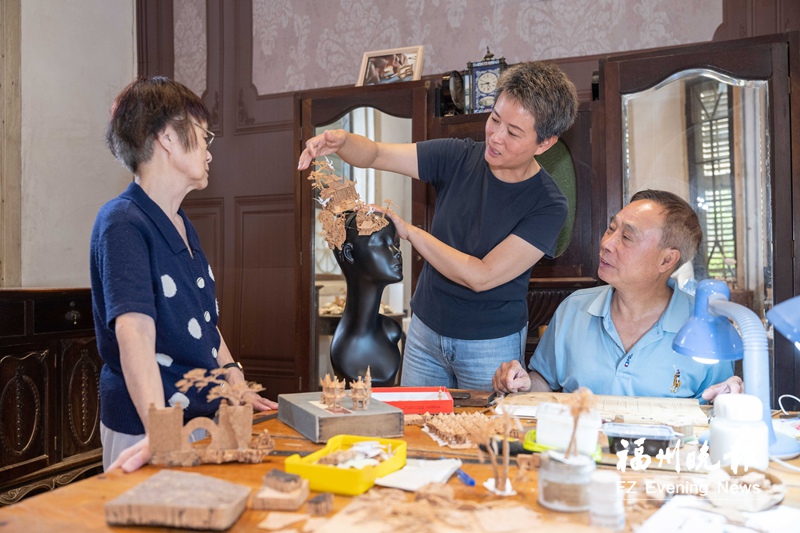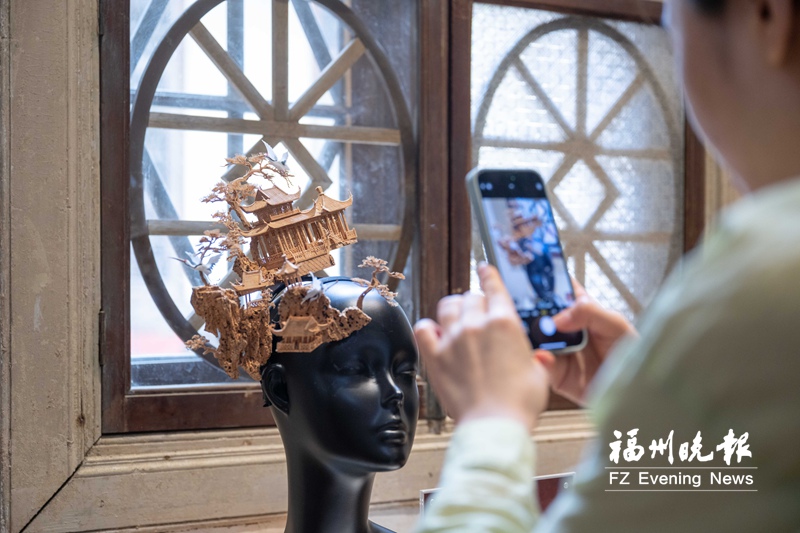From “Admired from Afar” to “Worn by Celebrities” Fuzhou Cork Painting Rises as the “New National Trend”
What is the most popular intangible cultural heritage in Fuzhou right now? Cork painting certainly holds a prominent place.
When Zhao Liying glanced back at Caifeng Villa, the tiny pavilions and towers nestled in her hair, alongside the soaring pine crane, formed a charmingly whimsical scene... A recent photo spread in Shang Cheng Shi quickly went viral on social media, and Fuzhou’s cork painting, an intangible cultural heritage, has captured the hearts of young people.
In no time, cork paintings as headpieces became a viral trend. Various cork painting hair accessories, styled like those worn by celebrities, have become a hit in Fuzhou’s travel photography scene, breathing new life and attention into this intangible cultural heritage craft.
However, beneath the frenzy of viral trends lies a deeper question: how can we move beyond fleeting “Internet fame” to achieve lasting success and shift from temporary “traffic” to sustained engagement? This is prompting a new wave of thinking in the industry about the preservation and innovation of intangible cultural heritage.

Hu Lijuan (center) was working on cork painting hair accessories with two veteran artisans.
A Century-Old Intangible Cultural Heritage, A Stunning Headwear
Cork painting, often referred to as a “silent poem” and a “three-dimensional painting,” originated in Fuzhou in the early 20th century and has endured a hundred years of ups and downs.
“Sushang Cork” is the creator of the cork painting hair accessories featured in Shang Cheng Shi. Long before the invitation from Shang Cheng Shi came, its owner, Hu Lijuan, had spent nearly 20 years tirelessly seeking a future for cork painting. In 2016, she teamed up with nine masters from the state-run cork painting factory, including Lin Youju, Chen Kongguo, and Wu Ruizhen, to establish “Sushang Cork” and launch a full-scale design innovation for cork painting.
This pioneer in preserving intangible cultural heritage quickly realized that cork painting’s decline stemmed from an overfocus on “artistic form” at the expense of its “artistic essence.” In response, she and her team creatively reimagined cork painting, turning it into high-end custom pieces, cultural gifts, and trendy items, showing young people that “cork painting can be so much more.”
As a result, “Sushang Cork” caught the eye of Shang Cheng Shi. In March this year, the team of Shang Cheng Shi traveled to Fuzhou to meet with Hu Lijuan and her crew to discuss a cork painting shoot. The biggest challenge, however, was figuring out the best way to showcase the cork paintings.
“At first, they proposed showcasing it through clothing, but the timeline was tight, and it didn’t capture the essence of cork painting. After several discussions, we decided to present it through headpieces instead,” said Hu Lijuan.
After finalizing the size of the headpieces and components like pavilions, towers, flowers, and trees, the three master artisans from “Sushang Cork” got to work. Ten days later, three boxes filled with over a hundred pieces were ready to be displayed. The Shang Cheng Shi team set out the requirements for assembly and aesthetics, and Hu Lijuan guided the artisans in assembling the pieces.
When they learned the project was about headpieces, the three master artisans thought it was “too unconventional.” “Cork painting is a soft material, traditionally meant to be admired from a distance—‘look, but don’t touch.’ Let alone turning it into headpieces,” said 75-year-old Chen Xuerong. 76-year-old Chen Kongguo was puzzled: “If it’s meant to be worn on the head, why not wear it straight? Why do these 90s and 00s generations insist on wearing it a little askew?”
Hu Lijuan reassured them, saying, “The older generation of artisans has their aesthetic values and traditions, but change is necessary for progress. If we want young people to fall in love with cork painting, we need to embrace a more modern sense of style.”
After over 20 days of design and creation, the cork painting headpieces that went viral online were finally born.

The cork painting hair accessories created by “Sushang Cork” for Shang Cheng Shi.
Rapidly Igniting a Trend of Photo-Taking
A small piece of cork holds a world of wonders, and the ancient charm of Fuzhou is woven into every strand of hair. In April, after Shang Cheng Shi released its photos, Fuzhou’s cork painting quickly gained widespread attention. Topics like “Celebrity-inspired cork painting headpieces,” “Explore Fuzhou’s intangible cultural heritage cork painting with Zhao Liying,” and “Take a photo in Fuzhou with Zhao Liying’s signature look” went viral on social media. Actress Yang Xue and numerous influencers posted stunning photos of themselves wearing cork painting headpieces, commenting, “Traditional Chinese aesthetics are so refined!”
The growing popularity of cork painting has also sparked a rise in makeup and styling experiences. During a recent visit, the reporter found that several travel photography businesses in Fuzhou, including Jinhuage, Xinghui Art Space, and Gucuo Shiguang Guochao Travel Photography, have introduced cork painting-themed photo shoots, drawing tourists to Fuzhou to experience this unique trend.
At Xinghui Art Space in Zhuzifang, Fujian Arts & Crafts Industry Co., Ltd. (also known as “Fujian Arts & Crafts”), a state-owned enterprise, has partnered with Xinghui Art Space to launch four cork painting headpieces. Designed by Fujian Arts & Crafts and crafted by the Wu Zhisheng Master Studio, the headpieces blend traditional elements like flowers, trees, pavilions, and towers with distinctive Fuzhou features, including the Wuta Tower, White Pagoda, and saddle walls.
“The sample photography for our first headpiece was completed on May 4, and right after that, we received five customer orders. The first was from the influencer Xiaozhuizi, who has 6 million followers on Douyin. So far, more than 30 customer groups have experienced the headpieces, many of whom are out-of-town visitors specifically coming for the cork painting experience,” said Hu Lei, the owner of Xinghui Art Space.
Fujian Arts & Crafts is a leading enterprise in the Fujian arts and crafts industry, dedicated to the preservation, innovation, and promotion of Fujian’s traditional arts and crafts. A relevant responsible person from Fujian Arts & Crafts said, “While traditional cork painting is celebrated for its exquisite aesthetic value, its lack of practicality has made it harder to engage younger audiences. In recent years, the Fujian arts and crafts industry has been seeking new ways to reinvent cork painting. This time, by capitalizing on Zhao Liying’s popularity, and transforming cork painting into headpieces, incorporating it into makeup and styling, we’ve sparked fresh ideas for innovation in the industry. These cork painting headpieces allow this intangible cultural heritage to become part of daily life as “wearable art,” fostering a deeper connection with modern living and revitalizing its appeal among younger generations.”
“How many more surprises does Fuzhou have in store?” wrote Xiao Wu, a tourist from Jiangxi, on her WeChat Moments recently. Last year, she kept coming across videos of the Fuzhou Three Hairpins and decided she had to visit Fuzhou for a photo shoot experience. Last month, she was captivated once again by the cork painting headpieces and quickly convinced her best friend to join her for a check-in in Fuzhou. “The Three Hairpins are both soft and strong, and the cork painting is classical and elegant. With both forms of intangible heritage adorning my head, it felt as though I had woven Fuzhou’s timeless stories into my hairstyle,” said Xiao Wu.

Models wearing cork painting headpieces appeared in Shangxiahang.
How to Turn Fleeting “Traffic” into Sustained Engagement?
In the 1980s, cork painting was a major export product for Fuzhou, with tens of thousands of people working in the industry. However, by the 1990s, the market started to decline. The products failed to evolve with the times, and today, few young people are entering the field.
“I’m so happy and honored to see Zhao Liying wearing the cork painting headpiece,” said Chen Kongguo, expressing the deep emotions of a veteran artisan. As a national-level senior technician, he apprenticed under Chinese arts and crafts master Wu Xuebao and has witnessed the rise and fall of cork painting over his more than 60 years in the industry. Now, with the surge of attention it’s receiving, he feels genuinely gratified. The other four master artisans from “Sushang Cork,” 75-year-old Chen Xuerong, 68-year-old Zheng Huaqin, 66-year-old Xiao Meiying, and 74-year-old Lin Youju, with an average age of around 70, shared the same feeling. For decades, they’ve watched the craft decline, caught in a cycle of “learning without practicing,” always hoping that cork painting would once again regain its former glory.
Amid the frenzy of social media traffic, the Fujian arts and crafts industry has come to realize that the buzz around “Internet fame” is short-lived. The key to shifting cork painting from temporary “traffic” to sustained engagement lies in unlocking its inherent creative potential.
“Today, more and more young people are moving away from blindly pursuing luxury and complexity, instead gravitating toward a simple yet refined ‘sense of elegance.’ When traditional craftsmanship meets modern aesthetics, it can still evoke that same ‘sense of elegance,’” said Hu Lijuan.
In recent years, “Sushang Cork” has not only been delving into the cultural richness of cork painting but has also been constantly innovating, creating fresh takes on the craft. They’ve developed items such as makeup bags, brooches, small ornaments, cushions, and wellness combs, all incorporating modern aesthetics and fashion elements. These cork painting products strike a balance between practicality and traditional aesthetics, showcasing the renewed charm of this traditional craft. Some of these products have even gone into mass production. Additionally, they’ve fused cork painting with Shoushan stone carving, bodiless lacquerware, and lacquer art, launching creative cultural products for the tourism market. “Cork painting has limitless potential for future development, and we should never rush to define it,” said Hu Lijuan.
In addition, Fujian Arts & Crafts is planning to collaborate with master studios to introduce a variety of cork painting cultural products, such as postcards, scented items, fashion accessories, notebooks, refrigerator magnets, and more, bringing cork painting into everyday life.
“Only by appealing to young people can we attract them and ensure the continuation of this industry,” said a relevant responsible person from Fujian Arts & Crafts. They also plan to host cork painting-themed exhibitions to further ignite the creative passion of the younger generation and inject new vitality into the industry’s growth.
Shang Cheng Shi has also brought Caifeng Villa into the spotlight. Every day, a steady stream of visitors discovers cork painting in this ancient building. They constantly exclaim, “This is amazing!” and “How unique!”—their compliments bring a deep sense of satisfaction to Hu Lijuan. What left a lasting impression on her was when an elderly man walked in recently, shared his memories of cork painting, and then, with great care, asked, “This headpiece is beautiful. May I try it on?” When he donned the headpiece and smiled with childlike joy, Hu Lijuan didn’t see the end of an intangible cultural heritage; she saw the start of a new chapter. “As long as there are people who love it, cork painting will never disappear.” (Fuzhou Evening News Reporters: Chen Dan, Ma Liqing/Text; Lin Shuangwei/Photo)